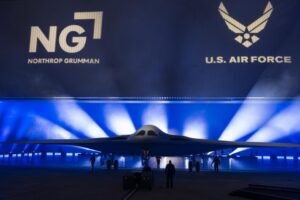Northrop Grumman [NOC] on Friday publicly unveiled the new B-21 Raider, the Air Force’s new stealth bomber and the first sixth-generation aircraft.
The ceremony in Palmdale, California at the Air Force’s Plant 42 follows years of secrecy around the B-21 to protect sensitive program details, and arrives as the aircraft is scheduled to make its first flight in 2023.

“As the most advanced stealth aircraft, [the B-21] will be the backbone of U.S. air power. The world has never seen technology like the B-21,” Kathy Warden, CEO of Northrop Grumman, told the crowd gathered at the event. “The next time you see this plane it’ll be in the air.”
Northrop Grumman has confirmed six B-21s are in various stages of final assembly, with Warden adding that the next steps of the program are “robust ground testing and toward first flight.”
In 2015, Northrop Grumman was awarded the Long Range Strike Bomber contract to develop the B-21, beating out a Lockheed Martin [LMT]-Boeing [BA] team, with the Air Force planning to buy at least 100 of the new aircraft.
Defense Secretary Lloyd Austin, who was joined by senior Pentagon and Air Force officials as well as members of Congress at the event, noted the B-21 is the first strategic bomber rolled out in three decades.
“The B-21’s edge will last for decades to come,” Austin said. “We will soon fly this aircraft, test it and then move it into production. And we will build the bomber force in numbers suited to the strategic environment ahead.”
The Air Force’s fiscal year 2023 budget request contained the first procurement funding for the B-21, calling for nearly $1.8 billion for the low-rate initial production (LRIP) phase.
Gen. Charles Q. Brown Jr., the Air Force chief of staff, told reporters ahead of the unveiling ceremony he expects delivery of the first B-21s in the “mid-’20’s”
During the roundtable discussion with reporters, Andrew Hunter, the Air Force’s top acquisition official, said the B-21 program remains on cost and schedule.
“One of the key aspects of this program is that we had a very firm cost target that is a requirement for the program, and that will support our ability to deliver the number of aircraft we need to truly perform the missions that are outlined in the National Defense Strategy for the Air Force,” Hunter said. “Overall, the program has been tracking very well to plan. So we’re meeting the key elements of the schedule that government had established.”
Along with the B-21’s role as a stealth bomber, Austin said the aircraft will be tasked with “gathering intel to battle management to integrating with our allies and partners.”
“The B-21 looks imposing. But what’s under the frame and the space age coatings is even more impressive,” Austin said. “Let’s talk about the B-21’s range. No other other long-range bomber can match its efficiency. It won’t need to be based in-theater. It won’t need logistical support to hold any target at risk. Let’s talk about the B-21’s stealth. 50 years of advances in low-observable technology have gone into this aircraft, and even those sophisticated air defense systems will struggle to detect the B-21 in the sky. Let’s talk about the B-21’s durability. You know, we really don’t have a capability unless we can maintain it. And the B-21 was carefully designed to be the most maintainable bomber ever built. And let’s talk about what the B-21 can deliver. The Raider is designed to deliver both conventional and nuclear munitions with formidable precision.”
Northrop Grumman also noted the B-21 has been designed with an open architecture to allow for rapid technology insertion rather than undergoing block upgrades, with Austin also remarking on the platform’s ability to continue adapting in the future.
“The [B-21] Raider was built with an open system architecture which makes it highly adaptable. So as the United States continues to innovate, this bomber will be able to defend our country with new weapons that haven’t even been invented yet,” Austin said.
Warden, in the discussion with reporters ahead of the unveiling ceremony, also responded to a question on how sizable the B-21 portion is to the company’s revenue portfolio.
“In terms of the B-21, it’s an important part of our company’s revenue. But it’s only about 10 percent of the company today. As we look into 2023, that’s relatively stable. We’ve spoken about that in a public form and we expect it to scale over time,” Warden said.